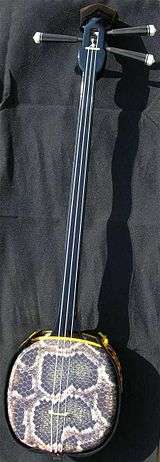Sanshin

The sanshin (三線, literally "three strings") is an Okinawan musical instrument and precursor of the Japanese shamisen. Often likened to a banjo, it consists of a snakeskin-covered body, neck and three strings.

History
Is close resemblance in both appearance and name to the Chinese sanxian suggests its Chinese origins, the old Ryūkyū Kingdom (pre-Japanese Okinawa) having very close ties with China. In the 16th century, the sanshin reached the Japanese trading port at Sakai in Osaka, Japan. In mainland Japan, it evolved into the larger shamisen.
In mainland Japan, many people refer to the sanshin as jabisen (蛇皮線, literally "snake-skin strings") or jamisen (蛇三線, "snake three strings") because the body of the instrument has a snakeskin covering. Traditionally, it was covered with the skin of the Burmese python, but today, due to CITES regulations, the skin of the python reticulatus is also used. A bamboo bridge raises the strings off the skin.
The Okinawan names for the strings are (from thick to thin) uujiru (男絃, "male string"), nakajiru (中絃, "middle string"), and miijiru (女絃, "female string"). The strings are white, except in Amami, where they are yellow.
Traditionally, players wear a plectrum, made of a material such as the water buffalo horn, on the index finger. Today, some use a guitar pick or the nail of the index finger. In Amami, long, narrow bamboo plectra are also used, and the strings are yellow and thinner, which allow a higher-pitched tone than that of the Okinawa sanshin. In Amami, the sanshin is called shamisen 三味線.
In the years following World War II, many Okinawans made sanshin from empty tin cans, known as "kankara sanshin".
Due to international wildlife protection treaties, it is not legal to export snakeskin-covered sanshins to some countries (such as the United Kingdom and United States). There is some room for interpretation of this in that the treaties specify that the restriction is for endangered species of snake.
Python skin is used for the skin of the body of the instrument, in contrast to the cat or dogskin used traditionally on Japanese shamisen. Though Okinawa is famous for the venomous habu snake, the habu is in fact too small for its skin to be used to make sanshin, and it is believed that the snakeskin for sanshin has always been imported from Southeast Asia. Though the pythons used to make sanshin skins today are not an endangered species, the difficulty of distinguishing one snakeskin from another makes transporting real-skin (J: hongawa) sanshin internationally somewhat risky. However, cheaper sanshin with plastic skins are quite common today as well.
Tuning
The sanshin has five tunings called chindami (ちんだみ):[1]
- Hon chōshi (本調子) – "standard tuning" (i.e. C3, F3, C4 expressed in terms of scientific pitch notation)
- Ichi-agi chōshi (一揚調子) – "first-string raised tuning" (i.e. E♭3, F3, C4)
- Ni-agi chōshi (二揚調子) – "second-string raised tuning" (i.e. C3, G3, C4)
- Ichi, ni-agi chōshi (一、二揚調子) – "first- and second-strings raised tuning" (i.e. D3, G3, C4)
- San-sage chōshi (三下げ調子) – "third-string lowered tuning" (i.e. C3, F3, B♭3)
See also
References
- ↑ 滝原, 康盛 (1964). Ryūkyū minyō kunkunshi 琉球民謡工工四. Ryūkyū ongaku gakufu kenkyūsho 琉球音楽楽譜研究所, Naha, Okinawa.
http://wiki.samurai-archives.com/index.php?title=Sanshin
External links
- Simple Sanshin Source - An English-written guide to the sanshin.
- iSanshin - Sanshin Application on iPhone/iPodtouch
- Tuning - Sanshin Tuning Guide